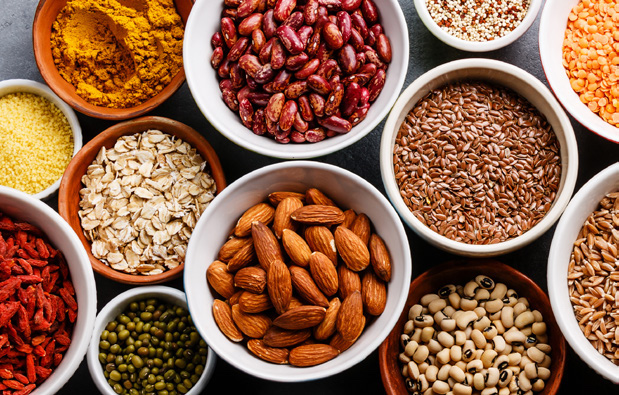“Eating plans” are everywhere—online, in the gym, on social media. But how can you decide which one works for you? Learn more below about the pros and cons of some popular eating styles that might help you manage your weight.
Mediterranean diet
 A very popular eating pattern that has decades of evidence to suggest it’s a nutritious and satisfying approach to eating is the “Mediterranean diet.” Following this eating style supports health and longevity and decreases risk of heart disease.
A very popular eating pattern that has decades of evidence to suggest it’s a nutritious and satisfying approach to eating is the “Mediterranean diet.” Following this eating style supports health and longevity and decreases risk of heart disease.
- What it typically includes: Whole grains, fresh fruits, vegetables, legumes (beans, peas, lentils, peanuts), healthy fats (especially olive oil), nuts, herbs, and spices; small amounts of protein such as fish and seafood twice a week; and other proteins such as poultry, eggs, dairy (cheese or yogurt) in small portions either daily or a few times per week.
- What it typically limits: Added sugars, desserts, and red meats.
- Risks: Potential for excess calories (no specific amounts or portions are recommended); requires meal planning and cooking, which can take more time than you might be used to.
- Where to learn more: The Nutrition Source from Harvard’s School of Public Health
Dietary Approaches to Stop Hypertension (DASH) diet
The DASH diet is similar to the Mediterranean diet, but with guidance on the intake of certain electrolytes that can affect cardiac and smooth muscle functions to support healthy blood pressure. This includes eating more foods that are high in magnesium and potassium and limiting sodium (salt). And it recommends a specific number of servings of foods.
- What it typically includes: Fruits, vegetables, low-fat milk, whole grains, fish, poultry, beans, and nuts.
- What it typically limits: Salt, added sugars, and red meats.
- Risks: Limiting salt isn’t necessary if your blood pressure is healthy, and it isn’t advisable if you’re very active or if you work or live in a hot or humid environment. This plan also requires meal planning and cooking.
- Where to learn more: The National Heart, Lung, and Blood Institute
Paleo diet
A Paleo or “caveman” diet includes foods that were eaten during the Paleolithic era more than 2 million years ago. The focus is on eating fresh foods that Paleolithic (Stone-Age) humans would have hunted, fished, or gathered. Overall, this eating plan is high in protein, moderate in fat, and low to moderate in carbohydrates.
- What it typically includes: Foods “allowed” vary, but the general focus is on lean meats, fish, eggs, low-glycemic fruits, vegetables, nuts, seeds, olive oil, and coconut oil.
- What it typically excludes: Whole grains, cereals, dairy products, legumes (beans, peas, lentils, peanuts), white potatoes, alcohol, coffee, salt, canola oil, and most processed foods.
- Risks: Requires meal planning and preparation of fresh foods; higher cost for recommended meats (such as grass-fed beef); excludes popular and common foods or food groups (grains, dairy); high red-meat intake might adversely affect health; potentially low intake of certain vitamins and minerals (vitamin D, B vitamins, calcium).
- Where to learn more: Harvard’s “Diet review: Paleo diet for weight loss”
Plant-based (vegan, vegetarian)
Plant-based diets can range from having no animal products (vegan) to no animal meat (vegetarian) to those with limited animal products (plant-based or flexitarian). These diets are increasingly popular for their health benefits and lower impact on the environment.
- What it typically includes: Fruits, vegetables, grains, legumes (beans, peas, lentils, peanuts), nuts, seeds, fats; some include dairy, fish, eggs, or small amounts of meat or poultry, or all these.
- What it typically excludes: Some or all animal products, such as meat, fish, poultry, eggs, dairy (cheese, yogurt), milk, and honey.
- Risks: Can be low in protein or certain other nutrients (vitamin B12, vitamin D, iron) if not well planned. Vegan or vegetarian foods can still include processed foods.
- Where to learn more: American Heart Association’s “How does plant-forward (plant-based) eating benefit your health?”
- Read HPRC’s article on Plant-forward eating ideas to fuel your day.”
Ketogenic (“keto”) diet
 A ketogenic diet focuses on high-fat foods with moderate protein and low carbohydrate intake. Ketogenic diets have been used for years under medical supervision to treat specific medical conditions (such as epilepsy). The goal of “keto” is to limit glucose (by limiting carbs) and thus cause the body to use “ketones” from stored fat as fuel instead. Once stored glucose is depleted (usually after 3–4 days), the body begins to use ketones from fat as fuel.
A ketogenic diet focuses on high-fat foods with moderate protein and low carbohydrate intake. Ketogenic diets have been used for years under medical supervision to treat specific medical conditions (such as epilepsy). The goal of “keto” is to limit glucose (by limiting carbs) and thus cause the body to use “ketones” from stored fat as fuel instead. Once stored glucose is depleted (usually after 3–4 days), the body begins to use ketones from fat as fuel.
- What it typically includes: Guidance varies, but generally 70–80% of calories come from fat, 10–20% from protein, and 5–10% from carbs (usually < 50 grams per day). Recommended foods include high-fat foods such as avocado, coconut, certain nuts, and seeds; some dairy foods (butter, hard cheeses), grass-fed beef, free-range poultry, bacon, pork, wild-caught fish, eggs, tofu, non-starchy vegetables (such as: leafy greens, cauliflower, broccoli, peppers, onions, garlic, cucumbers, celery, mushrooms, summer squash), certain fruits in small portions (berries), dark chocolate, unsweetened coffee and tea, herbs, spices.
- What it typically excludes: Grains (whole and refined), added and natural sugars in foods and drinks, starchy vegetables (potatoes, corn, winter squash), most fruits, all fruit juices, legumes (beans, peas, lentils, peanuts).
- Risks: Can be difficult to maintain, especially long term or when training or on a mission; symptoms of very-low carb intake such as hunger, fatigue, irritability, constipation, headaches, and brain “fog”; limited variety can make dining out socially difficult; concerns that long-term use increases risk of kidney stones and osteoporosis; concerns about nutrient deficiencies if close attention isn’t paid to include a variety of food choices.
- Where to learn more: Harvard’s “Diet review: Ketogenic diet for weight loss”
Learn more at our “Get into Fighting Weight” guide.
